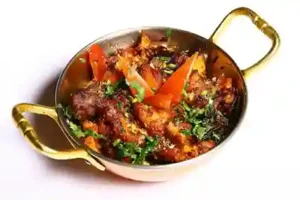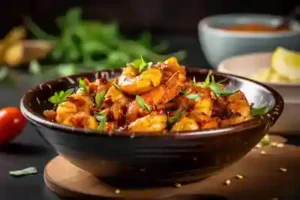Chicken Salan is a beloved staple in many South Asian households, known for its rich, flavorful gravy and tender chicken pieces. This dish combines aromatic spices and simple ingredients to create a comforting, hearty meal that pairs perfectly with rice or naan. Whether you’re new to South Asian cuisine or a seasoned cook, this recipe offers a delicious way to explore traditional flavors. Keep reading to discover how to make the perfect Chicken Salan at home, with tips and variations to suit every palate.

Introduction to Salan Recipe Chicken
Overview of Chicken Salan and Its Cultural Significance
Chicken Salan is a cherished dish in South Asian cuisine, particularly within Pakistani and Indian culinary traditions. “Salan” refers to a spiced, rich gravy that accompanies main dishes, and when combined with chicken, it creates a hearty and flavorful meal. This dish is often prepared during festive occasions, family gatherings, and special celebrations, reflecting the warmth and hospitality inherent in the region’s food culture. The preparation of Chicken Salan involves a harmonious blend of spices, herbs, and slow-cooked chicken, resulting in a deeply satisfying and aromatic experience that highlights the complexity and depth of South Asian flavors.
Why This Recipe is Loved by Many
Chicken Salan is adored for several reasons:
Rich and Complex Flavors:
The combination of spices such as cumin, coriander, turmeric, and garam masala creates a depth of flavor that is both aromatic and savory, appealing to a wide range of taste preferences.
Tender and Juicy Chicken:
Slow-cooking the chicken ensures it becomes tender and absorbs the flavors of the gravy, making each bite succulent and delicious.
Versatility:
This recipe can be easily adapted with various add-ins like vegetables, nuts, or dried fruits, allowing for customization based on personal preferences or dietary needs.
Comfort and Hearty Satisfaction:
The thick, flavorful gravy paired with chicken provides a comforting and satisfying meal, perfect for both everyday dinners and special occasions.
Cultural Connection:
For many, Chicken Salan evokes a sense of nostalgia and connection to cultural roots, making it a beloved dish passed down through generations.

Key Ingredients and Spices
Essential Ingredients for Chicken Salan
To make an authentic Chicken Salan, you’ll need a combination of fresh ingredients and traditional spices that come together to create a flavorful and aromatic dish. Here’s what you’ll need:
- Chicken: Bone-in pieces are preferred for a richer taste, but boneless chicken can be used for convenience. The bones add depth to the gravy, making it more flavorful.
- Onions: Finely sliced onions form the base of the gravy, providing sweetness and a subtle caramelized flavor.
- Tomatoes: Fresh, ripe tomatoes are essential for creating the tangy and slightly sweet base of the gravy.
- Ginger and Garlic Paste: A staple in South Asian cooking, this paste adds warmth and depth to the dish, enhancing the overall flavor.
- Green Chilies: These add a mild heat to the salan, balancing the richness of the gravy. Adjust the quantity based on your spice tolerance.
Importance of Specific Spices in Achieving the Authentic Flavor
The spices used in Chicken Salan are what give the dish its distinctive taste and aroma. Here’s a breakdown of the key spices:
- Cumin Seeds: Cumin seeds are often toasted in oil at the beginning of cooking, releasing a nutty, earthy flavor that forms the foundation of the dish.
- Coriander Powder: Coriander adds a subtle citrusy flavor with a hint of sweetness, complementing the other spices and balancing the heat.
- Turmeric Powder: This bright yellow spice gives the Chicken Salan its signature color and a slightly bitter, earthy taste. Turmeric also has anti-inflammatory properties, making it a healthy addition to the dish.
- Red Chili Powder: This spice adds heat and color to the salan. Adjust the amount to your preference, depending on how spicy you want the dish to be.
- Garam Masala: A blend of ground spices including cloves, cinnamon, and cardamom, garam masala is added towards the end of cooking to enhance the aroma and flavor of the dish.
- Bay Leaves and Cinnamon Stick: These whole spices are used during the initial cooking stages to infuse the oil with their warm, aromatic flavors, which permeate the entire dish.
- Fenugreek Leaves (Methi): Dried fenugreek leaves add a slight bitterness and a complex herbal flavor, rounding out the richness of the gravy.
Ingredient Notes and Possible Substitutions
- Chicken: If you prefer a lighter version, you can use skinless chicken breasts or thighs. However, for the most authentic taste, bone-in chicken is recommended.
- Tomatoes: If fresh tomatoes are not available, you can use canned tomatoes or tomato puree, though the flavor will be slightly different.
- Ginger and Garlic Paste: Freshly ground ginger and garlic provide the best flavor, but store-bought paste can be used for convenience.
- Spices: If you’re missing a specific spice, you can make small adjustments, but for the best results, try to use all the spices listed. For instance, if you don’t have garam masala, you can create a quick mix with ground cinnamon, cloves, and cardamom.
- Green Chilies: If you want to reduce the heat, you can omit the green chilies or replace them with a milder pepper like bell pepper.

Step-by-Step Instructions
Creating the perfect Chicken Salan involves a series of carefully executed steps that build flavor and texture, resulting in a rich and satisfying dish. Here’s how to do it:
Preparing the Ingredients
- Chicken: If using bone-in chicken, cut it into medium-sized pieces. Rinse and pat dry with paper towels. If using boneless chicken, cut it into bite-sized chunks.
- Onions: Finely slice the onions. The finer the slices, the quicker they’ll caramelize and blend into the gravy.
- Tomatoes: Chop the tomatoes into small pieces. You can also puree them for a smoother gravy.
- Ginger and Garlic Paste: If making fresh paste, use equal parts ginger and garlic, and grind them together with a little water until smooth.
- Spices: Measure out all your spices beforehand to ensure a smooth cooking process.
Sautéing the Onions and Spices
- Heat the Oil: In a large pot or deep pan, heat a few tablespoons of oil over medium heat. The oil should be hot but not smoking.
- Add Whole Spices: Start by adding the cumin seeds, bay leaves, and cinnamon stick to the hot oil. Sauté for about 30 seconds until they release their aroma.
- Caramelize the Onions: Add the finely sliced onions to the pan. Cook them, stirring frequently, until they turn golden brown. This process may take about 10-15 minutes. The caramelized onions form the base of the gravy, adding sweetness and depth of flavor.
- Ginger and Garlic Paste: Add the ginger and garlic paste to the onions. Sauté for another 2-3 minutes until the raw smell disappears and the paste blends with the onions.
Building the Gravy
- Add Tomatoes: Stir in the chopped or pureed tomatoes. Cook until the tomatoes soften and blend with the onion mixture, forming a thick paste. This should take about 5-7 minutes.
- Spice It Up: Add the ground spices—coriander powder, turmeric powder, red chili powder, and salt. Mix well, ensuring the spices coat the onion-tomato mixture evenly.
- Cook the Masala: Let the mixture cook on medium heat until the oil starts to separate from the masala (the onion-tomato-spice mixture). This step is crucial as it indicates that the spices are fully cooked and the flavors are well-developed.
Cooking the Chicken
- Add Chicken: Add the chicken pieces to the pot, ensuring they are well-coated with the masala. Cook for about 5-7 minutes, stirring occasionally, until the chicken starts to brown and sear.
- Add Water: Pour in enough water to cover the chicken, depending on how thick you want the gravy. For a thicker gravy, use less water. Stir well to combine.
- Simmer: Cover the pot with a lid and let the chicken cook on low to medium heat for 25-30 minutes. Stir occasionally to prevent sticking, and ensure the chicken cooks evenly.
Perfecting the Gravy
- Check for Doneness: After simmering, check if the chicken is cooked through and tender. The gravy should have thickened, with oil rising to the top, indicating that the dish is ready.
- Adjust Consistency: If the gravy is too thick, you can add a little more water and simmer for a few extra minutes. If it’s too thin, cook uncovered for a few minutes to let the excess liquid evaporate.
- Add Garam Masala and Finishing Touches: In the last 5 minutes of cooking, stir in the garam masala and dried fenugreek leaves (if using). These spices add a final layer of aroma and flavor to the Chicken Salan.
Resting and Serving
- Let It Rest: Once the Chicken Salan is cooked, turn off the heat and let it rest, covered, for about 10 minutes. This allows the flavors to meld together.
- Garnish: Before serving, garnish with freshly chopped coriander leaves for a burst of freshness.
- Serve: Chicken Salan is best enjoyed with steamed basmati rice, naan, or roti. Serve it hot, with additional garnishes like lemon wedges or sliced onions if desired.
Tips for Achieving the Perfect Texture and Flavor
- Caramelizing Onions: Take your time with the onions; properly caramelized onions are key to a flavorful gravy.
- Cooking the Masala: Ensure the onion-tomato-spice mixture is well-cooked before adding the chicken. The oil separating from the masala is a sign that it’s ready.
- Simmering: Slow cooking allows the chicken to absorb the flavors and ensures tenderness. Avoid rushing this step.
How to Make a Smooth and Rich Chicken Salan
For a smoother gravy:
- Use an Immersion Blender: After cooking the masala but before adding the chicken, blend the onion-tomato mixture with an immersion blender until smooth. This step creates a velvety texture in the gravy.
- Regular Blender Option: If you don’t have an immersion blender, you can cool the masala slightly and blend it in a regular blender before returning it to the pot.

Tips and Tricks for Perfecting Chicken Salan
Mastering Chicken Salan involves more than just following a recipe. To elevate your dish to restaurant-quality levels, consider these expert tips and tricks that can make a significant difference in flavor, texture, and presentation.
Balancing Spices for Optimal Flavor
- Use Fresh Spices: Freshly ground spices yield the best flavor. If possible, grind whole spices like cumin and coriander right before use to maximize their potency.
- Layering Spices: Add whole spices at the beginning of cooking to infuse the oil with their aroma, then introduce ground spices later to build complexity in the gravy.
- Controlling Heat: Adjust the amount of red chili powder and green chilies to suit your spice tolerance. If you’re sensitive to heat, start with a smaller amount and taste as you go.
- Garam Masala: Add garam masala towards the end of cooking. This ensures the aromatic qualities of the blend remain intact, providing a final burst of flavor without overpowering the dish.
Achieving the Perfect Gravy Consistency
- Caramelizing Onions: The key to a rich, flavorful gravy is properly caramelized onions. Take your time with this step, ensuring the onions turn a deep golden brown without burning. This process develops sweetness and depth, which forms the backbone of the salan.
- Tomato Cooking Time: Cook the tomatoes until they break down completely and merge with the onions to form a cohesive base. This step helps avoid a watery or chunky gravy.
- Controlling Gravy Thickness: For a thicker gravy, cook uncovered towards the end to let excess water evaporate. For a thinner consistency, add a bit more water or stock and simmer until you achieve the desired texture.
- Blending the Gravy: If you prefer a smooth gravy, blend the onion-tomato mixture before adding the chicken. An immersion blender is convenient for this, but a regular blender works too. This creates a velvety, restaurant-style gravy.
Enhancing Flavor with Fresh Herbs and Add-ins
- Fresh Coriander: Adding freshly chopped coriander leaves just before serving brightens the dish and adds a fresh, herbaceous note that complements the richness of the gravy.
- Fenugreek Leaves (Methi): Dried fenugreek leaves add a subtle bitterness and complexity. Crush them between your fingers before adding them to release their flavor. This is especially effective towards the end of cooking.
- Lemon Juice: A squeeze of fresh lemon juice at the end can lift the flavors, cutting through the richness and adding a touch of acidity that balances the dish.
Cooking Techniques for Tender Chicken
- Marinating the Chicken: For extra flavor and tenderness, marinate the chicken in a mixture of yogurt, ginger-garlic paste, and spices for at least 30 minutes before cooking. This step is optional but highly recommended.
- Searing the Chicken: When adding the chicken to the masala, make sure the heat is high enough to sear the meat. This locks in juices and gives the chicken a slight crust that enhances texture.
- Slow Cooking: Once the chicken is added to the gravy, reduce the heat and let it simmer gently. Slow cooking ensures the chicken remains tender and absorbs the flavors of the gravy.
Adjusting the Recipe for Variations
- Vegetarian Option: Replace chicken with paneer, tofu, or vegetables like potatoes, cauliflower, or peas. Adjust cooking times accordingly.
- Coconut Milk for Creaminess: For a richer, creamier gravy, add a splash of coconut milk towards the end of cooking. This variation is especially popular in South Indian versions of chicken salan.
- Adding Nuts and Raisins: For a festive touch, add toasted cashews or almonds and a handful of raisins. These add a sweet and nutty contrast to the savory gravy.
Serving and Presentation Tips
- Serving with Rice or Bread: Chicken Salan pairs beautifully with steamed basmati rice, naan, or roti. For a special occasion, serve it with fragrant pilaf or buttered naan.
- Garnishing: Garnish the dish with freshly chopped coriander, thinly sliced onions, and lemon wedges. For a vibrant presentation, sprinkle a pinch of garam masala on top just before serving.
- Serving in a Traditional Dish: For an authentic presentation, serve Chicken Salan in a traditional karahi (a type of wok) or a rustic clay pot. This not only enhances the visual appeal but also keeps the dish warm.

Common Mistakes to Avoid
When preparing Chicken Salan, several common pitfalls can affect the final result. Avoiding these mistakes will help you achieve a rich, flavorful, and well-balanced dish. Here’s a guide to common errors and how to steer clear of them:
Under-Cooking or Over-Cooking the Onions
- Mistake: Not caramelizing onions properly can result in a bland or overly sharp taste in the gravy.
- Solution: Cook the onions slowly over medium heat until they turn a deep golden brown. This process can take about 10-15 minutes. Patience is key here—undercooked onions can affect the overall depth and sweetness of the gravy.
Skipping the Spice Tempering
- Mistake: Not tempering or toasting whole spices at the beginning can lead to a less aromatic dish.
- Solution: Always toast whole spices like cumin seeds, bay leaves, and cinnamon sticks in hot oil before adding other ingredients. This step enhances their flavors and infuses the oil with their essential oils, setting a flavorful base for the gravy.
Not Cooking the Tomato Mixture Enough
- Mistake: Adding tomatoes and not cooking them down thoroughly can leave a raw tomato taste and a watery gravy.
- Solution: Cook the tomato-onion mixture until the oil starts separating from the masala. This ensures that the tomatoes are fully broken down and the flavors are well-developed.
Over-Spicing or Under-Spicing
- Mistake: Using too much or too little spice can overpower the dish or leave it bland.
- Solution: Measure your spices accurately and taste the gravy as it cooks. Adjust the seasoning gradually, adding more spice or salt as needed. Remember that spices should enhance, not dominate, the dish.
Not Adjusting Gravy Consistency
- Mistake: Ending up with either too thick or too thin gravy due to improper water adjustments.
- Solution: Add water gradually, starting with less and adding more if necessary. If the gravy is too thin, simmer uncovered to reduce the liquid. If too thick, add a bit more water and cook until you reach the desired consistency.
Ignoring Marination
- Mistake: Not marinating the chicken or using unseasoned chicken can result in bland meat.
- Solution: Marinate the chicken with yogurt, ginger-garlic paste, and spices for at least 30 minutes to allow the flavors to penetrate the meat. This step adds depth and tenderness to the chicken.
Cooking Chicken Too Quickly
- Mistake: Cooking the chicken on high heat can result in tough, dry meat and unevenly cooked pieces.
- Solution: Cook the chicken over medium heat, allowing it to simmer slowly in the gravy. This ensures the chicken stays tender and absorbs all the flavors.
Not Using Enough Oil
- Mistake: Using too little oil can cause the spices to burn and affect the texture of the gravy.
- Solution: Use a sufficient amount of oil to sauté the onions and spices. The oil not only helps in cooking but also contributes to the richness of the gravy.
Forgetting to Add Finishing Touches
- Mistake: Omitting the final touches like garam masala, fenugreek leaves, or fresh coriander can lead to a less vibrant flavor profile.
- Solution: Add garam masala and fenugreek leaves towards the end of cooking to enhance the aroma and flavor. Garnish with fresh coriander just before serving to add a burst of freshness.
Not Letting the Dish Rest
- Mistake: Serving the Chicken Salan immediately after cooking without letting it rest can result in less integrated flavors.
- Solution: Allow the dish to rest for about 10 minutes after cooking. This resting period helps the flavors meld together and improves the overall taste of the salan.

Variations and Additions to Chicken Salan
Chicken Salan is a versatile dish that can be customized to suit different tastes and preferences. Whether you’re looking to make it spicier, creamier, or a bit different from the traditional recipe, here are some variations and additions you can try:
Regional Variations
Hyderabadi Chicken Salan:
This version often includes peanuts and coconut in the gravy, giving it a rich, nutty flavor. To make it, grind a handful of roasted peanuts and fresh coconut into a paste and add it to the masala. Adjust the spices to suit your taste.
Karachi Style Chicken Salan:
Known for its bold, spicy flavor, this variation uses a higher quantity of chili powder and green chilies. You can also include more tomatoes for a tangier gravy. Garnish with fresh coriander and a squeeze of lemon juice for an extra kick.
Punjabi Chicken Salan:
Punjabi versions might include additional spices like amchur (dried mango powder) for a tangy twist. You can also add a splash of cream at the end to make the gravy richer and creamier.
Adding Vegetables
Mixed Vegetables:
For a heartier dish, add vegetables like potatoes, carrots, and peas along with the chicken. These should be added at the same time as the chicken to ensure they cook through and absorb the flavors of the gravy.
Spinach or Kale:
Adding leafy greens like spinach or kale towards the end of cooking can boost the nutritional value of the dish. Simply stir them in until wilted and tender.
Creamy Variations
Coconut Milk:
For a creamy and slightly sweet flavor, add a cup of coconut milk towards the end of cooking. This is especially popular in South Indian versions and complements the spices well.
Heavy Cream or Yogurt:
Stir in a few tablespoons of heavy cream or yogurt at the end of cooking for a richer texture. Make sure to lower the heat before adding dairy to prevent curdling.
Adding Nuts and Dried Fruits
Cashews and Almonds:
Toasted cashews or almonds can be added to the gravy for a crunchy texture and nutty flavor. You can either grind them into a paste or add them whole towards the end of cooking.
Raisins:
A handful of raisins can add a touch of sweetness and contrast to the savory flavors of the dish. Add them along with the nuts or near the end of cooking.
Spice Variations
Cinnamon and Cloves:
For a more aromatic touch, add a cinnamon stick and a few cloves while cooking the onions and spices. These spices add depth and complexity to the flavor profile.
Star Anise:
A single star anise can be added for a unique, slightly licorice-like flavor. Remove it before serving, as it’s quite strong and not meant to be eaten.
Vegetarian Alternatives
Paneer:
Replace chicken with paneer (Indian cottage cheese) for a vegetarian version. Paneer cubes absorb the flavors of the gravy beautifully and provide a hearty alternative to meat.
Tofu:
For a vegan option, use firm tofu instead of chicken. Marinate the tofu cubes before adding them to the gravy to enhance their flavor and texture.
Chickpeas:
Chickpeas (garbanzo beans) are another great alternative, offering a protein-packed and satisfying option for vegetarians. Add them along with the tomatoes and let them simmer until tender.
Garnishes and Accompaniments
Fried Onions:
Top the Chicken Salan with crispy fried onions for added texture and a burst of flavor. These can be bought pre-made or made at home.
Boiled Eggs:
Adding halved boiled eggs to the dish towards the end of cooking is a popular addition in some regions. They soak up the flavors of the gravy and add richness.
Lemon Wedges:
Serve with lemon wedges on the side. A squeeze of fresh lemon juice just before eating can enhance the flavors and add a refreshing tang.
Heat Level Adjustments
Mild Version:
To make the dish milder, reduce the amount of chili powder and skip the green chilies. You can add a pinch of sugar to balance the flavors if desired.
Extra Spicy:
For an extra kick, increase the quantity of red chili powder and fresh green chilies. You can also add a teaspoon of chili flakes for added heat.

Serving and Presentation Tips
How you serve and present Chicken Salan can greatly enhance the dining experience. Whether you’re preparing it for a casual family meal or a special occasion, these tips will help you serve it in a way that’s both visually appealing and delicious.
Choosing the Right Accompaniments
- Rice: Chicken Salan pairs excellently with various types of rice. Basmati rice, with its fragrant aroma and long grains, is a traditional choice. For a more elaborate meal, serve it with saffron-infused rice or a fragrant pilaf.
- Bread: Naan, roti, or paratha are ideal for scooping up the rich gravy. You can opt for plain naan or try variations like garlic naan or butter naan for extra flavor.
- Side Dishes: Complement the salan with side dishes such as raita (yogurt sauce with cucumbers and herbs) or a fresh salad with a tangy vinaigrette. These additions provide a refreshing contrast to the rich, spiced gravy.
Presentation Ideas
- Serving Dish: Serve Chicken Salan in a traditional Indian dish like a karahi (wok) or a brass serving bowl. These dishes add authenticity and help retain the heat.
- Garnishing: Enhance the dish with a garnish of fresh coriander leaves, thinly sliced onions, and a sprinkle of garam masala. You can also add a few fried onions or a drizzle of cream for an extra touch of elegance.
- Accompaniments Arrangement: Arrange the rice and bread attractively on the plate or in separate bowls alongside the Chicken Salan. For a more formal presentation, serve each component separately, allowing guests to customize their portions.
Portioning
- Serving Size: For a balanced meal, serve a generous portion of Chicken Salan with a moderate amount of rice or bread. A standard serving is typically around one cup of salan with half a cup of rice or two pieces of bread.
- Family Style: For family gatherings, serve the Chicken Salan in a large bowl or dish at the center of the table, allowing everyone to help themselves. This approach fosters a communal dining experience and makes serving easier.
Temperature
- Serving Hot: Chicken Salan is best enjoyed hot. Ensure that it is heated thoroughly before serving. If it’s been cooked ahead of time, gently reheat it on the stove or in the oven to avoid overcooking.
- Keeping Warm: Use a chafing dish or a slow cooker with a warm setting to keep the salan warm if you’re serving it over a longer period. This is particularly useful for buffet-style meals or parties.
Enhancing the Dining Experience
- Acidity: Serve Chicken Salan with a side of lemon wedges. A squeeze of fresh lemon juice just before eating can brighten the flavors and add a refreshing zing.
- Beverages: Pair the dish with a cooling beverage such as lassi (a yogurt-based drink), a refreshing mint lemonade, or even a light, crisp white wine if you’re serving it in a more formal setting.
- Table Setting: Create a pleasant dining atmosphere by setting the table with appropriate cutlery and napkins. Use vibrant tablecloths or placemats to complement the colors of the dish and add visual appeal.
Special Occasions
- Festive Presentations: For special occasions like festivals or gatherings, consider adding decorative elements such as flower petals or colorful napkins. You can also serve the salan in ornate serving dishes to add a festive touch.
- Themed Dinners: If hosting a themed dinner, coordinate the presentation of Chicken Salan with other dishes and decor to match the theme. This can include traditional decorations, specific table settings, or complementary side dishes.

Storage and Reheating Tips
Proper storage and reheating are crucial for maintaining the quality and safety of Chicken Salan. Here are some detailed tips to help you store and reheat your dish effectively:
Storage Guidelines
Cooling:
Allow Chicken Salan to cool to room temperature before storing. This prevents condensation in the storage container, which can affect the texture and flavor of the dish.
Containers:
Store the salan in airtight containers to preserve its freshness and prevent contamination. Glass containers or high-quality plastic containers with tight-fitting lids work well.
Refrigeration:
Place the container in the refrigerator within two hours of cooking. Chicken Salan can be safely stored in the refrigerator for up to 3-4 days.
Freezing:
For longer storage, Chicken Salan can be frozen. Transfer the cooled salan to freezer-safe containers or heavy-duty freezer bags. Label the containers with the date for easy tracking. The dish can be frozen for up to 3 months.
Reheating Tips
Thawing:
If frozen, thaw Chicken Salan in the refrigerator overnight before reheating. This ensures even heating and reduces the risk of bacterial growth.
Stovetop Method:
Reheat the salan on the stovetop over medium heat. Stir occasionally to ensure even heating. Add a splash of water or broth if the gravy has thickened too much during storage. Heat until it reaches an internal temperature of 165°F (74°C).
Microwave Method:
For quicker reheating, use a microwave-safe dish. Heat the salan in short intervals, stirring in between to promote even heating. Cover the dish to prevent splatters and retain moisture. Ensure the salan is heated to 165°F (74°C) throughout.
Oven Method:
Preheat the oven to 350°F (175°C). Place the salan in an oven-safe dish and cover with foil to prevent drying out. Heat for about 20-30 minutes, stirring halfway through. Check that the salan is heated to 165°F (74°C) before serving.
Handling Leftovers
Portioning:
To avoid repeated reheating, portion out only what you need for each meal. This helps maintain the quality of the remaining salan and reduces the risk of overcooking.
Avoid Refreezing:
Do not refreeze Chicken Salan that has been previously thawed and reheated. This can compromise the texture and safety of the dish.
Safety Considerations
Bacterial Growth:
Keep the salan at safe temperatures. Do not leave it at room temperature for more than two hours to prevent bacterial growth.
Reheat Thoroughly:
Always reheat Chicken Salan until it is steaming hot throughout. This ensures that any potential bacteria are destroyed and that the dish is safe to eat.
Flavor Maintenance
Moisture:
When reheating, adding a bit of liquid (such as water or broth) can help restore the gravy’s original consistency and prevent it from becoming too thick.
Spice Adjustment:
Sometimes, flavors can mellow out during storage. Taste the salan after reheating and adjust seasoning as needed, adding a pinch of salt or a dash of spice if necessary.

Nutrition and Health Considerations
Chicken Salan is a flavorful and satisfying dish, but understanding its nutritional content and health considerations can help you make informed choices about incorporating it into your diet. Here’s a detailed look at the nutrition and health aspects of Chicken Salan:
Nutritional Breakdown
Chicken Salan
typically includes chicken, spices, onions, tomatoes, and sometimes yogurt or cream. The exact nutritional content can vary based on the specific recipe and ingredients used. Here is a general breakdown of the main components:
- Chicken: A good source of high-quality protein, essential for muscle repair and growth. It also provides important nutrients like B vitamins (especially B6 and B12), selenium, and zinc.
- Spices: Spices like turmeric, cumin, and coriander offer various health benefits. Turmeric contains curcumin, known for its anti-inflammatory and antioxidant properties. Cumin aids digestion, and coriander can help with blood sugar control.
- Onions and Tomatoes: These vegetables are low in calories and rich in vitamins and minerals. Onions provide antioxidants like quercetin, and tomatoes are high in vitamins C and K and lycopene, an antioxidant linked to heart health.
Caloric Content
The calorie content of Chicken Salan can vary depending on the ingredients and preparation methods. A typical serving of Chicken Salan (about 1 cup) can range from 300 to 500 calories. This includes:
- Chicken: Provides about 150-200 calories per 3.5 oz (100 grams) of cooked chicken.
- Gravy: The caloric content can increase with the addition of oil, cream, or yogurt. Creamy versions can be higher in calories compared to those made with just spices and tomatoes.
Fat Content
The fat content in Chicken Salan varies based on the cooking method and ingredients used:
- Chicken: Skinless chicken breasts have lower fat compared to thighs or drumsticks. Chicken thighs or drumsticks add more fat but also more flavor.
- Cooking Oil: The type and amount of oil used can impact the fat content. Opting for healthier oils like olive oil can reduce saturated fat.
- Cream or Yogurt: Using cream increases the fat content, whereas yogurt (especially low-fat versions) can be a lighter option.
Sodium Levels
Chicken Salan can be high in sodium due to the use of salt and certain spices or pre-made spice blends. High sodium intake can contribute to health issues like hypertension. To manage sodium levels:
- Limit added salt: Use low-sodium or no-sodium-added spice blends.
- Monitor portion sizes: Keep an eye on serving sizes to control sodium intake.
- Rinse canned ingredients: If using canned tomatoes, rinse them to reduce sodium content.
Dietary Considerations
- Protein: Chicken Salan is a good source of protein, which is essential for muscle repair and overall health. For those on a low-carb diet, it’s a suitable option, provided that the recipe doesn’t include high-carb ingredients.
- Carbohydrates: The dish itself is relatively low in carbohydrates, but this can change depending on the side dishes served with it (e.g., rice or naan). For a low-carb option, pair it with cauliflower rice or skip the bread.
- Fat: Depending on the recipe, Chicken Salan can be moderate to high in fat. Using lean cuts of chicken and reducing or substituting cream can help lower the fat content.
Health Benefits
- Antioxidants: Spices like turmeric and cumin have antioxidant properties, which can help protect cells from damage and reduce inflammation.
- Digestive Health: Cumin and coriander are known for aiding digestion and may help in managing digestive issues.
- Heart Health: Ingredients like tomatoes and onions, which are rich in vitamins and antioxidants, support cardiovascular health.
Modifications for Healthier Options
- Lower Fat: Use low-fat yogurt instead of cream. Opt for skinless chicken breasts to reduce fat content.
- Reduce Sodium: Use fresh or homemade spice blends to control sodium levels. Limit the addition of salt during cooking.
- Increase Vegetables: Add vegetables like spinach or bell peppers to boost the nutritional content and fiber.
Portion Control
- Serving Size: Stick to recommended serving sizes to manage calorie and fat intake. A typical serving size is about 1 cup of Chicken Salan.
- Balanced Meals: Combine Chicken Salan with a side of vegetables and a moderate portion of rice or bread to create a balanced meal that covers various nutritional needs.

Salan Recipe Chicken
Ingredients
- 500 g chicken cut into medium pieces
- 2 onions finely sliced
- 2 tomatoes chopped
- 1/2 cup yogurt
- 2-3 green chilies slit
- 1 tablespoon ginger-garlic paste
- 1/2 teaspoon turmeric powder
- 1 teaspoon red chili powder
- 1 teaspoon coriander powder
- 1 teaspoon cumin seeds
- 1/2 teaspoon garam masala powder
- 1/4 teaspoon black pepper powder
- Salt to taste
- 1/2 cup cooking oil or ghee
- Fresh coriander leaves for garnish
- Water as needed
Instructions
- In a large pan, heat the cooking oil or ghee over medium heat.
- Add the sliced onions and fry until they turn golden brown.
- Stir in the ginger-garlic paste and sauté for a couple of minutes until the raw smell disappears.
- Add the chopped tomatoes and cook until they soften and blend with the onions, forming a smooth mixture.
- Sprinkle in the turmeric powder, red chili powder, coriander powder, and cumin seeds. Cook the mixture for 2-3 minutes until the oil begins to separate from the masala.
- Add the chicken pieces and mix well to coat them with the masala. Cook the chicken on medium heat for about 5-7 minutes until it turns white.
- Lower the heat and stir in the yogurt. Cook for another 5 minutes, stirring continuously to avoid curdling.
- Pour in enough water to create a gravy, depending on your desired consistency. Bring the salan to a boil, then reduce the heat and let it simmer.
- Cover the pan and let the chicken cook for about 20-25 minutes on low heat until it's fully cooked and tender. Stir occasionally.
- Add salt, garam masala powder, black pepper powder, and slit green chilies. Mix well and cook for an additional 5 minutes.
- Garnish the Chicken Salan with fresh coriander leaves. Serve hot with naan, roti, or rice.
- Enjoy your delicious Chicken Salan!
